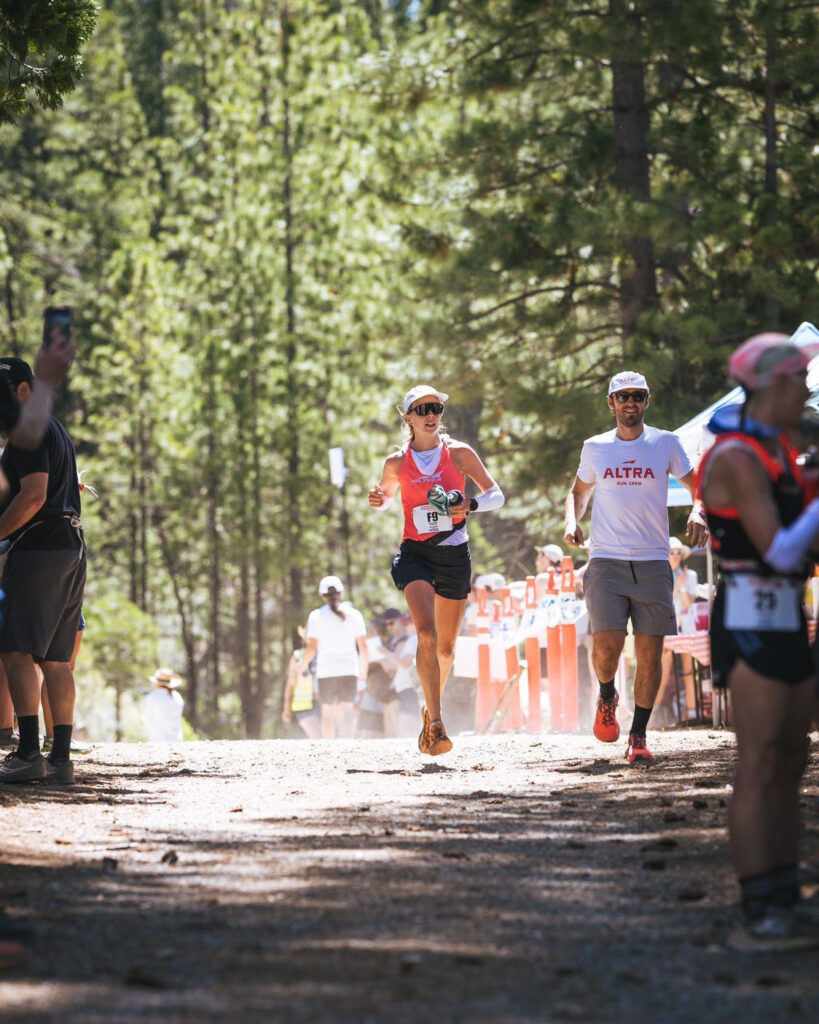Editor’s Note: This is the second in a three part series by our resident ultra-nerd, Keely Henninger, which will address the current state of mental and physical health, body image, and fueling in trail and ultrarunning community. You can read part one here.
“You don’t look like a runner.”
This stereotyped, completely arbitrary phrase is used to question someone’s belonging in our community. However innocent the phrase may feel to the person who delivers it, this type of comment only serves to reinforce the harmful narrative that has driven this sport for years. For too long, we have used things like how we look or the number on the scale to represent our success in running. If I look this way, hit this number on a scale, or resemble <insert name of an athlete who has completely different genetics than you>, then I’ll be the fastest I can be. I will be successful. However, if we don’t look like a runner, can we still be a runner? If we win a race, but don’t look like a runner, does it still count? The answer is unequivocally yes. If you run, you’re a runner. These unhealthy milestones can drive some athletes to take extreme measures to reach an arbitrary body ideal. These extreme measures can result in a lot of downstream negative health outcomes like mental health disorders, disordered eating, and in some cases, low energy availability that manifests in many ways (9). The good news is, we don’t have to let this outdated narrative define us, we get to define our own journey by nourishing our bodies and training in a way that lets us reach our own potential, not constantly striving for someone else’s. This article aims to discuss the prevalence of body image issues and body satisfaction in sport, how they may impact behavior and overall health and performance, and how we can start to address some of these issues to slowly redefine what it means to be successful.
We put a lot of weight in the words of others
Winning my first 50-mile trail race in the PNW, I was given a nickname by a spectator. Running in the lead against a stout field at mile 30, I was whittled down to “Big Girl” by an enthusiastic and arrogant fan. They didn’t know that I was a 22-year-old girl constantly struggling with acceptance in a new sport. They didn’t know that I dwelled on that nickname for years. They didn’t know a lot, and I suppose that’s the point. We don’t know what is going on inside, so we shouldn’t make comments about our subjective perception of the outside. We don’t get to justify our preconceived narrative by commenting on someone else’s appearance. Nicknames seem harmless and silly, however, oftentimes it’s these nicknames or comments from those in our surrounding sporting community that hit us the hardest (5). The same goes for throwaway phrases like “you look fast.” Do I look fast or am I fast? Words matter, they stick, they have impact.
Body image issues can impact all athletes
Where did this narrative come from, anyhow? Why are some athletes unhappy with their body and constantly seeking to change? Body image can be influenced through societal norms, peer pressure, and social media use. The dramatic rise in social media use by athletes exposes them to a constant stream of unrealistic images. This increase in exposure to social media has been linked to increased body dissatisfaction in athletes and non-athletes alike (10,11).
Athletes that are dissatisfied with their body may display a drive for thinness and/or a desire to change it (6, 8). It should come as no surprise that this decrease in body satisfaction can also directly impact self-confidence and self-worth in athletes (6). Athletes of all body sizes can have body dissatisfaction, and some athletes, specifically females who are already lean or at a low weight, may even think they need to be lighter or wear a smaller clothing size to fit in (6, 8). In a world full of brands that share no consistent sizing or fit guide, let’s debunk that one right here: what size apparel you wear does not matter. Depending on the brand, I may own something 3 sizes smaller or bigger. The sizing world is ludicrous.
Chasing a body ideal may not improve health or performance
Body dissatisfaction and societal pressure are known to play a role in the development of disordered eating habits in athletes independent of gender (6). Some athletes who are not satisfied with their bodies may intentionally restrict calorie intake to try to alter their appearance (6). Due to the mindset, lighter is faster, these issues are prevalent in endurance athletes, specifically distance runners (3). While this might work in the short term, depriving your body of energy and nutrients to lose unnecessary weight will not make you faster in the long-term. Berg et al (2022) recently found that body weight did not correspond to fastest marathon time or prevalence of disordered eating in female Olympic marathon trials runners (1). Many other studies have started to debunk this trend as well, showing that BMI or body weight is not correlated to performance outcomes, especially in female athletes (7, 2)
I can’t tell you how many personal anecdotes I have heard from fellow runners who have based their barometer of success around how they look, not how they perform. I’ve seen a lot of stellar athletes enter the sport just to leave it as quickly as they entered due to injury or illness. I’ve heard countless horror stories from young athletes being forced to fit into X size running apparel or being told to mimic the behavior of other sick teammates who “look fitter.” Unfortunately, even today a lot of prestigious running programs are still being accused of body shaming and/or body fat monitoring of athletes to encourage them to reach unrealistic body standards (4, 12). A body ideal. Perhaps this is where we have gone wrong.
In a sport full of highly driven perfectionists, we do not need to be striving for this unrealistic body ideal. The body ideal we have constructed in our heads is just that, an ideal construct, not a healthy or realistic one. These body image issues impact athletes of all ages, abilities, and sizes, and can be a driving force behind other destructive and performance-limiting behaviors and conditions like disordered eating and low energy availability. We need to start changing the narrative that is fed to athletes and coaches alike, emphasizing health instead of weight and tracking performance metrics in place of body fat percentages.

Body image is a really tricky topic and I hope that my little tidbits below can start to mold a new narrative in your mind.
The Takeaways
Body image issues are common
You are not alone, and you probably have friends or acquaintances with the same thoughts that you struggle with. Sometimes saying this stuff out loud lets us normalize it and highlights how unrealistic it may be.
One size does not fit all
You may never look like your neighbor, and that’s okay. We will never reach our true potential trying to live someone else’s life. Train hard, rest hard, and treat your body well and it will reach its perfect size that allows you to have energy to push yourself to new heights.
Long term success trumps short term success
We have all seen athletes enter the limelight after a stellar race win, to only watch them leave the sport injured dealing with an eating disorder or body image issues. Are you willing to sacrifice an entire career for one good season? One good race? A successful runner is built over time, if we don’t stay in the sport long enough to build our base, we will never know what we are actually capable of. Prioritize the long term.
Prioritize performance and health
Are you getting faster? Recovering well? It’s okay to track fitness progression and critically assess how you are trending. You can also track things like sleep quality, mood, injury prevalence, menstrual status (for females) and sex-drive over time and look for changes since these metrics can indicate improper training:recovery in some athletes.
Your words matter
If we ever feel like we want to make a comment about someone’s body or how they look, take an extra breath, ask yourself how it would make you feel. More times than not it’s not additive or productive.
For a long time, we have been told that achieving a body ideal will result in an increase in performance. It is finally time to flip the narrative around. Striving to reach your own unique potential will lead you to finding your own ideal body. Strive to train your body diligently, recover harder, and fuel well so that you can run your best. Strive to get to a day where the reflection in the mirror doesn’t matter. The shorts size doesn’t matter. You love you. Strive to get to a place where you are staying true to yourself, enjoying your training, pushing yourself, and because of that reaching new heights. Because of that you can’t be bothered to even lend a critical eye towards your external appearance because you are beaming too brightly from the inside. If you run, you’re a runner – how freeing does that sound?
References
(1)Berg, Sophia, et al. “Self Reported History of Eating Disorders, Training, Weight Control Methods, and Body Satisfaction in Elite Female Runners Competing at the 2020 U.S. Olympic Marathon Trials.” International Journal of Exercise Science, vol. 15, no. 2, Jan. 2022.
(2)Citarella, Roberto, et al. “Association between Dietary Practice, Body Composition, Training Volume and Sport Performance in 100-Km Elite Ultramarathon Runners.” Clinical Nutrition ESPEN, vol. 42, Apr. 2021, pp. 239–43, https://doi.org/10.1016/j.clnesp.2021.01.029.
(3)Fitts, V., et al. “Exploring Relationships of Disordered Eating and Body Dissatisfaction with Lean Versus Non-Lean Athletes.” Journal of the Academy of Nutrition and Dietetics, vol. 122, no. 9, Sept. 2022, p. A61, https://doi.org/10.1016/j.jand.2022.06.197.
(4)Ken Goe for The Oregonian/OregonLive. “Women Athletes Allege Body Shaming within Oregon Ducks Track and Field Program.” Oregonlive, 25 Oct. 2021, https://www.oregonlive.com/trackandfield/2021/10/women-athletes-allege-body-shaming-within-oregon-ducks-track-and-field-program.html. Accessed 31 Dec. 2022.
(5)Goodwin, Huw, et al. “Critical Comments Concerning Shape and Weight: Associations with Eating Psychopathology among Full-Time Dance Students.” Eating and Weight Disorders – Studies on Anorexia, Bulimia and Obesity, vol. 19, no. 1, Oct. 2013, pp. 115–18, https://doi.org/10.1007/s40519-013-0075-2.
(6)Jagim, Andrew R., et al. “Contributing Factors to Low Energy Availability in Female Athletes: A Narrative Review of Energy Availability, Training Demands, Nutrition Barriers, Body Image, and Disordered Eating.” Nutrients, vol. 14, no. 5, Feb. 2022, p. 986, https://doi.org/10.3390/nu14050986.
(7)Kuznetsov, Alexandra, et al. “Abstract 495: A Reappraisal of Body Mass Index and Aerobic Fitness in Young Athletic Women.” Circulation Research, vol. 127, no. Suppl_1, July 2020, https://doi.org/10.1161/res.127.suppl_1.495.
(8)Levine, Michael P., and Sarah K. Murnen. “‘Everybody Knows That Mass Media Are/Are Not [ Pick One ] a Cause of Eating Disorders’: A Critical Review…” Guilford Press, 1 Jan. 2009, https://www.researchgate.net/publication/247839433_Everybody_Knows_That_Mass_Media_areare_not_pick_one_a_Cause_of_Eating_Disorders_A_Critical_Review_of_Evidence_for_a_Causal_Link_Between_Media_Negative_Body_Image_and_Disordered_Eating_in_Females. Accessed 31 Dec. 2022.
(9)Mountjoy, Margo, et al. “IOC Consensus Statement on Relative Energy Deficiency in Sport (RED-S): 2018 Update – PubMed.” British Journal of Sports Medicine, vol. 52, no. 11, June 2018, https://doi.org/10.1136/bjsports-2018-099193.
(10)Perloff, R. “[PDF] Social Media Effects on Young Women’s Body Image Concerns: Theoretical Perspectives and an Agenda for Research.” Sex Roles. vol 71 no 11, 2014. Accessed 31 Dec. 2022.
(11) Swami, V., et al. “A Comparison of Body Size Ideals, Body Dissatisfaction, and Media Influence between Female Track Athletes, Martial Artists, and Non-Athletes.” Psychology of Sport and Exercise, vol. 10, no. 6, pp. 609–14, https://doi.org/10.1016/j.psychsport.2009.03.003. Accessed 31 Dec. 2022.
(12) Thames, Alanis, and Jonathan Abrams. “Female College Athletes Say Pressure to Cut Body Fat Is Toxic.” The New York Times, 10 Nov. 2022, https://www.nytimes.com/2022/11/10/sports/college-athletes-body-fat-women.html. Accessed 31 Dec. 2022.
